2015 MITSUBISHI OUTLANDER SPORT wheel
[x] Cancel search: wheelPage 349 of 384
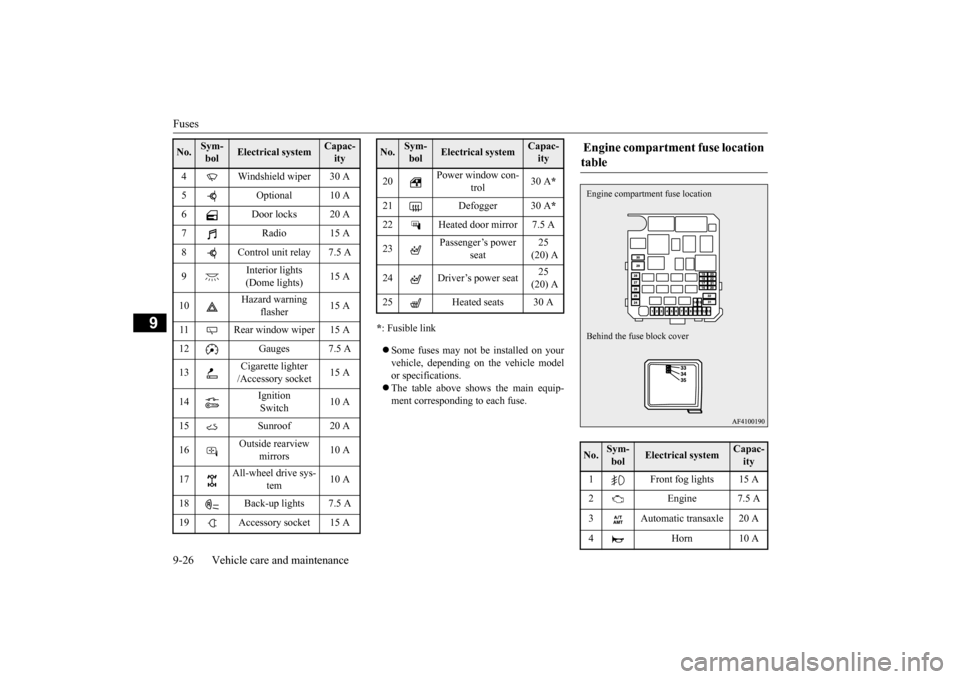
Fuses 9-26 Vehicle care and maintenance
9
* : Fusible link Some fuses may not be installed on your vehicle, depending on the vehicle model or specifications. The table above shows the main equip- ment corresponding to each fuse.
4 Windshield wiper 30 A 5 Optional 10 A 6 Door locks 20 A 7 Radio 15 A8 Control unit relay 7.5 A 9
Interior lights (Dome lights)
15 A
10
Hazard warning
flasher
15 A
11 Rear window wiper 15 A 12 Gauges 7.5 A 13
Cigarette lighter /Accessory socket
15 A
14
Ignition Switch
10 A
15 Sunroof 20 A16
Outside rearview
mirrors
10 A
17
All-wheel drive sys-
tem
10 A
18 Back-up lights 7.5 A 19 Accessory socket 15 ANo.
Sym- bol
Electrical system
Capac-ity
20
Power window con-
trol
30 A
*
21 Defogger 30 A
*
22 Heated door mirror 7.5 A 23
Passenger’s power
seat
25 (20) A
24 Driver’s power seat
25 (20) A
25 Heated seats 30 ANo.
Sym- bol
Electrical system
Capac-ity
Engine compartment fuse location table No.
Sym- bol
Electrical system
Capac-ity
1 Front fog lights 15 A 2 Engine 7.5 A 3 Automatic transaxle 20 A 4 Horn 10 AEngine compartment
fuse location
Behind the fuse block cover
BK0206700US.bo
ok 26 ページ 2014年3月25日 火曜日 午後4時42分
Page 363 of 384
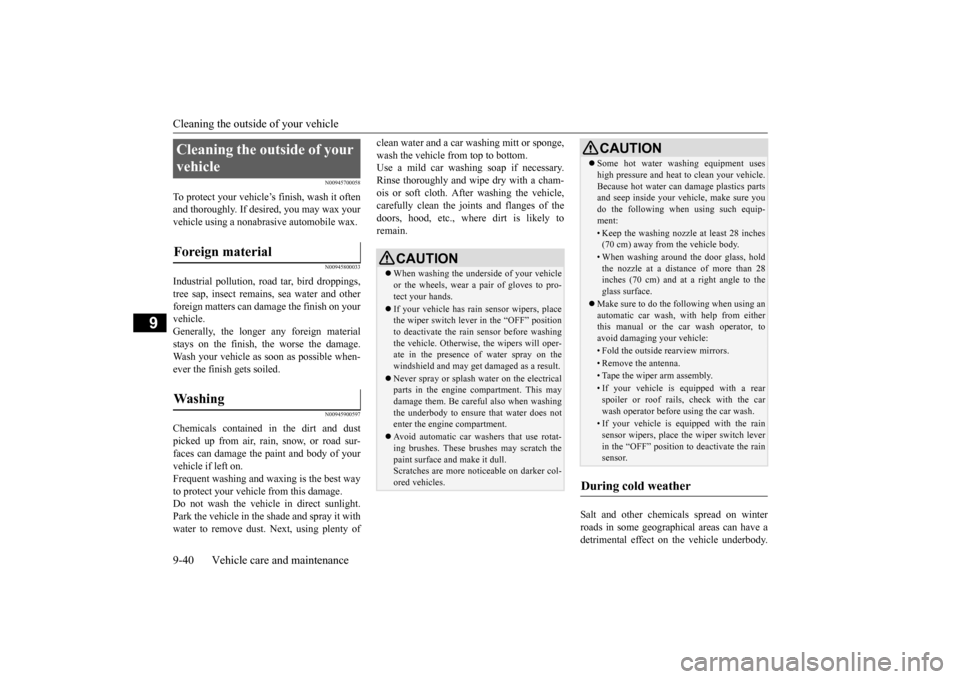
Cleaning the outside of your vehicle 9-40 Vehicle care and maintenance
9
N00945700058
To protect your vehicle’s finish, wash it often and thoroughly. If desired, you may wax yourvehicle using a nonabrasive automobile wax.
N00945800033
Industrial pollution, road tar, bird droppings,tree sap, insect remains, sea water and otherforeign matters can damage the finish on your vehicle. Generally, the longer any foreign materialstays on the finish, the worse the damage. Wash your vehicle as soon as possible when- ever the finish gets soiled.
N00945900597
Chemicals contained in the dirt and dustpicked up from air, rain, snow, or road sur-faces can damage the paint and body of your vehicle if left on. Frequent washing and waxing is the best wayto protect your vehicle from this damage. Do not wash the vehicle in direct sunlight. Park the vehicle in the shade and spray it withwater to remove dust. Next, using plenty of
clean water and a car washing mitt or sponge, wash the vehicle from top to bottom. Use a mild car washing soap if necessary. Rinse thoroughly and wipe dry with a cham-ois or soft cloth. After washing the vehicle, carefully clean the joints and flanges of the doors, hood, etc., where dirt is likely toremain.
Salt and other chemicals spread on winter roads in some geographical areas can have a detrimental effect on the vehicle underbody.
Cleaning the outside of your vehicle Foreign material Wa s h i n g
CAUTION When washing the underside of your vehicle or the wheels, wear a pair of gloves to pro- tect your hands. If your vehicle has rain sensor wipers, place the wiper switch lever in the “OFF” positionto deactivate the rain sensor before washing the vehicle. Otherwise, the wipers will oper- ate in the presence of water spray on thewindshield and may get damaged as a result. Never spray or splash water on the electrical parts in the engine compartment. This may damage them. Be careful also when washing the underbody to ensure that water does notenter the engine compartment. Avoid automatic car washers that use rotat- ing brushes. These brushes may scratch the paint surface and make it dull. Scratches are more noticeable on darker col- ored vehicles.
Some hot water washing equipment uses high pressure and heat to clean your vehicle. Because hot water can damage plastics parts and seep inside your vehicle, make sure you do the following when using such equip-ment:• Keep the washing nozzle at least 28 inches(70 cm) away from the vehicle body.• When washing around the door glass, holdthe nozzle at a distance of more than 28 inches (70 cm) and at a right angle to the glass surface.
Make sure to do the following when using an automatic car wash, with help from eitherthis manual or the car wash operator, to avoid damaging your vehicle:• Fold the outside rearview mirrors.• Remove the antenna.• Tape the wiper arm assembly.• If your vehicle is equipped with a rearspoiler or roof rails, check with the car wash operator before using the car wash.• If your vehicle is equipped with the rainsensor wipers, place the wiper switch leverin the “OFF” position to deactivate the rain sensor.
During cold weather
CAUTION
BK0206700US.bo
ok 40 ページ 2014年3月25日 火曜日 午後4時42分
Page 365 of 384
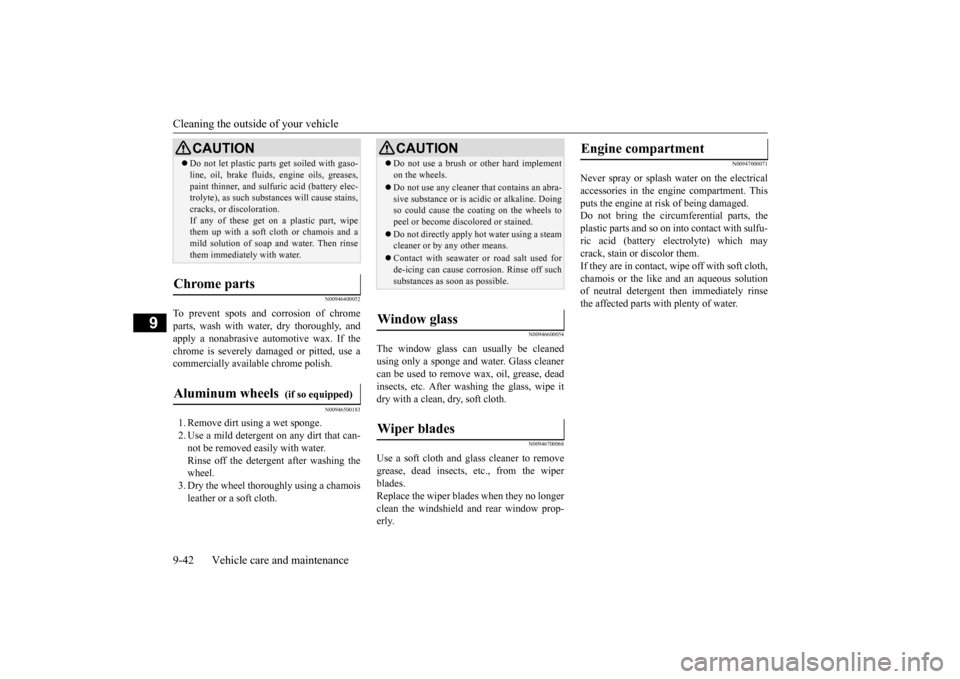
Cleaning the outside of your vehicle 9-42 Vehicle care and maintenance
9
N00946400052
To prevent spots and corrosion of chrome parts, wash with water, dry thoroughly, and apply a nonabrasive automotive wax. If thechrome is severely damaged or pitted, use a commercially available chrome polish.
N00946500183
1. Remove dirt using a wet sponge.2. Use a mild detergent on any dirt that can- not be removed easily with water.Rinse off the detergent after washing the wheel. 3. Dry the wheel thoroug
hly using a chamois
leather or a soft cloth.
N00946600054
The window glass can usually be cleanedusing only a sponge and water. Glass cleaner can be used to remove
wax, oil, grease, dead
insects, etc. After washing the glass, wipe itdry with a clean, dry, soft cloth.
N00946700068
Use a soft cloth and glass cleaner to removegrease, dead insects, etc., from the wiper blades. Replace the wiper blades when they no longerclean the windshield and rear window prop- erly.
N00947000071
Never spray or splash water on the electrical accessories in the engine compartment. Thisputs the engine at risk of being damaged. Do not bring the circumferential parts, the plastic parts and so on into contact with sulfu-ric acid (battery electrolyte) which may crack, stain or discolor them. If they are in contact, wipe off with soft cloth,chamois or the like and an aqueous solutionof neutral detergent then immediately rinse the affected parts with plenty of water.
Do not let plastic parts get soiled with gaso- line, oil, brake fluids
, engine oils, greases,
paint thinner, and sulfuric acid (battery elec- trolyte), as such substances will cause stains, cracks, or discoloration.If any of these get on a plastic part, wipe them up with a soft cloth or chamois and a mild solution of soap and water. Then rinsethem immediately with water.
Chrome parts Aluminum wheels
(if so equipped)
CAUTION
CAUTION Do not use a brush or other hard implement on the wheels. Do not use any cleaner that contains an abra- sive substance or is acidic or alkaline. Doingso could cause the coating on the wheels to peel or become discolored or stained. Do not directly apply hot water using a steam cleaner or by any other means. Contact with seawater or road salt used for de-icing can cause corrosion. Rinse off such substances as soon as possible.
Window glass Wiper blades
Engine compartment
BK0206700US.bo
ok 42 ページ 2014年3月25日 火曜日 午後4時42分
Page 367 of 384
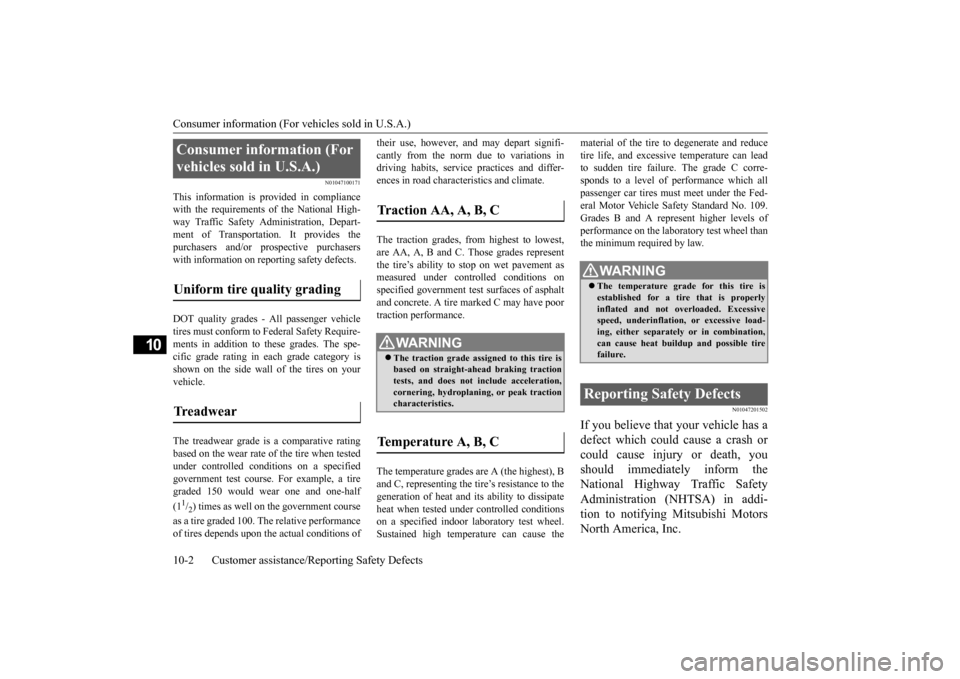
Consumer information (For vehicles sold in U.S.A.) 10-2 Customer assistance/Reporting Safety Defects
10
N01047100171
This information is provided in compliance with the requirements of the National High-way Traffic Safety Administration, Depart- ment of Transportation. It provides the purchasers and/or prospective purchaserswith information on reporting safety defects. DOT quality grades - All passenger vehicle tires must conform to Federal Safety Require-ments in addition to these grades. The spe- cific grade rating in each grade category is shown on the side wall of the tires on yourvehicle. The treadwear grade is a comparative rating based on the wear rate of the tire when tested under controlled conditions on a specified government test course. For example, a tiregraded 150 would wear one and one-half (11/2) times as well on the government course
as a tire graded 100. The relative performance of tires depends upon the actual conditions of
their use, however, and may depart signifi- cantly from the norm due to variations in driving habits, service practices and differ- ences in road characteristics and climate. The traction grades, from highest to lowest, are AA, A, B and C. Those grades representthe tire’s ability to stop on wet pavement asmeasured under controlled conditions on specified government test surfaces of asphalt and concrete. A tire marked C may have poortraction performance. The temperature grades are A (the highest), B and C, representing the tire’s resistance to thegeneration of heat and its ability to dissipate heat when tested under controlled conditions on a specified indoor laboratory test wheel.Sustained high temperature can cause the
material of the tire to degenerate and reduce tire life, and excessive temperature can lead to sudden tire failure. The grade C corre- sponds to a level of performance which allpassenger car tires must meet under the Fed- eral Motor Vehicle Safety Standard No. 109. Grades B and A represent higher levels ofperformance on the laboratory test wheel than the minimum required by law.
N01047201502
If you believe that your vehicle has a defect which could cause a crash or could cause injury or death, you should immediately inform the National Highway Traffic SafetyAdministration (NHTSA) in addi- tion to notifying Mitsubishi Motors North America, Inc.
Consumer information (For vehicles sold in U.S.A.) Uniform tire quality grading Treadwear
Traction AA, A, B, C
WA R N I N G The traction grade assigned to this tire is based on straight-ahead braking traction tests, and does not include acceleration, cornering, hydroplaning, or peak tractioncharacteristics.
Temperature A, B, C
WA R N I N G The temperature grade for this tire is established for a tire that is properly inflated and not overloaded. Excessive speed, underinflation, or excessive load-ing, either separately or in combination, can cause heat buildup and possible tire failure.
Reporting Safety Defects
BK0206700US.bo
ok 2 ページ 2014年3月25日 火曜日 午後4時42分
Page 372 of 384
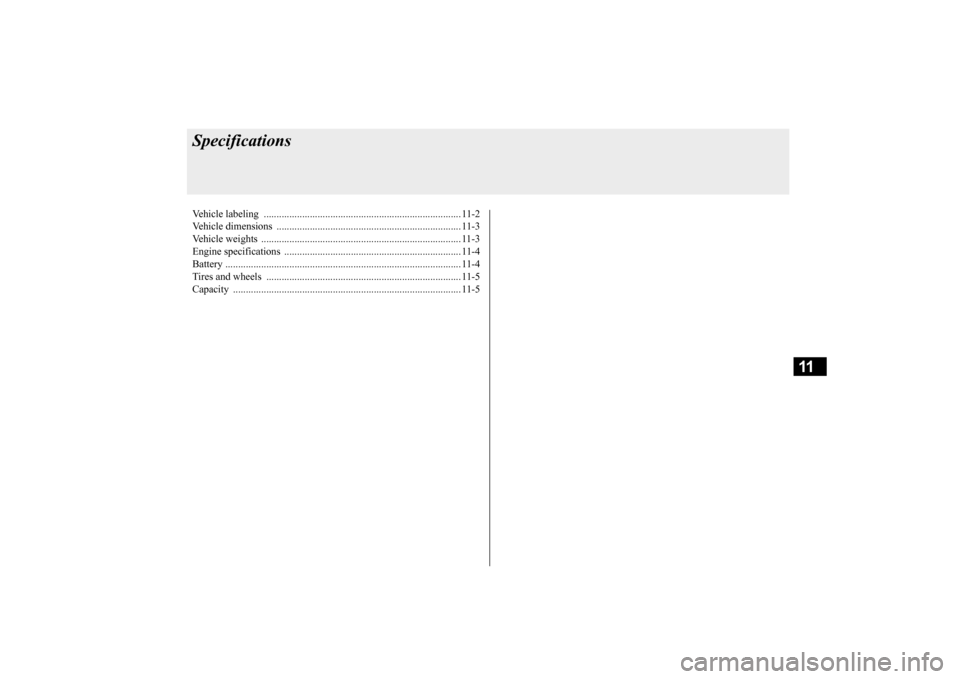
11
SpecificationsVehicle labeling ....
.................................................
........................ 11-2
Vehicle dimensions
................................................
........................ 11-3
Vehicle weights ...............
............................................................... 11-3
Engine specifications
.............................................
........................ 11-4
Battery .......................................
..................................................... 11-4
Tires and wheels .............
............................................................... 11-5
Capacity ....................................
..................................................... 11-5
BK0206700US.bo
ok 1 ページ 2014年3月25日 火曜日 午後4時42分
Page 374 of 384
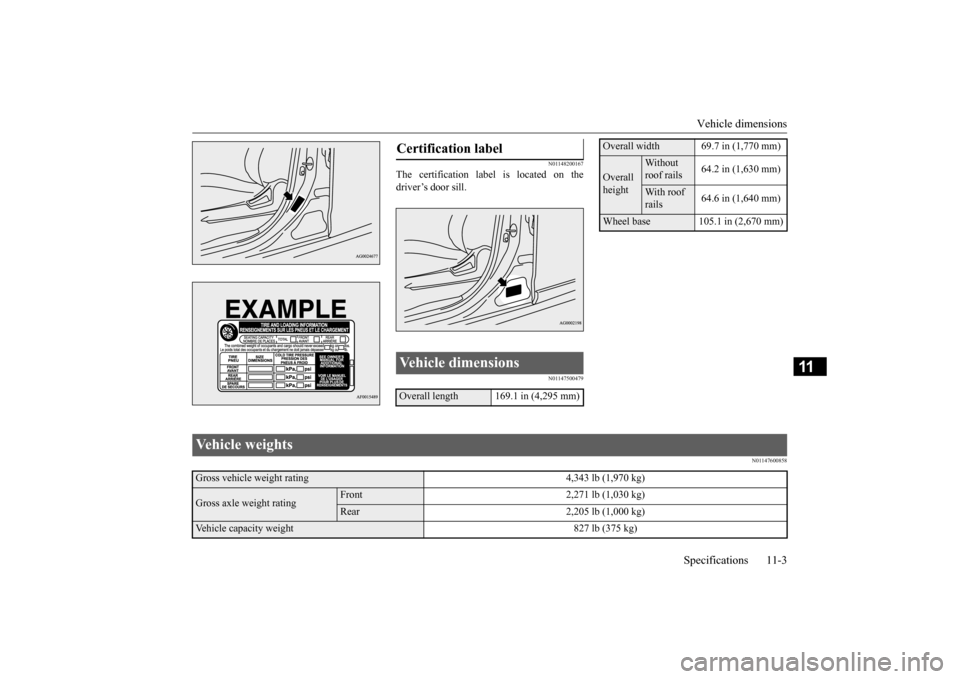
Vehicle dimensions
Specifications 11-3
11
N01148200167
The certification label is located on the driver’s door sill.
N01147500479
N01147600858
Certification label Vehicle dimensions Overall length 169.1 in (4,295 mm)
Overall width 69.7 in (1,770 mm)Overall height
Without roof rails
64.2 in (1,630 mm)
With roof rails
64.6 in (1,640 mm)
Wheel base 105.1 in (2,670 mm)
Vehicle weights Gross vehicle weight rating 4,343 lb (1,970 kg)Gross axle weight rating
Front 2,271 lb (1,030 kg)Rear 2,205 lb (1,000 kg)
Vehicle capacity weight 827 lb (375 kg)
BK0206700US.bo
ok 3 ページ 2014年3月25日 火曜日 午後4時42分
Page 376 of 384
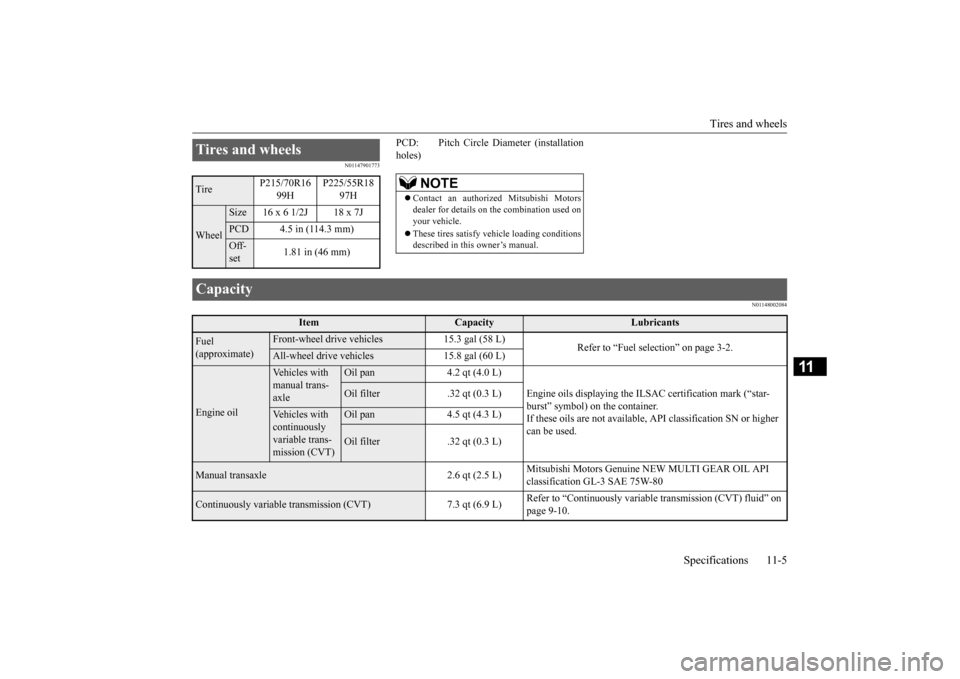
Tires and wheels
Specifications 11-5
11
N01147901773
PCD: Pitch Circle Diameter (installation holes)
N01148002084
Tires and wheels Tire
P215/70R16
99H
P225/55R18
97H
Wheel
Size 16 x 6 1/2J 18 x 7JPCD 4.5 in (114.3 mm)Off- set
1.81 in (46 mm)
NOTE
Contact an authorized Mitsubishi Motors dealer for details on the combination used on your vehicle. These tires satisfy vehicle loading conditions described in this owner’s manual.
Capacity
Item
Capacity
Lubricants
Fuel (approximate)
Front-wheel drive vehicles 15.3 gal (58 L)
Refer to “Fuel selection” on page 3-2.
All-wheel drive vehicles 15.8 gal (60 L)
Engine oil
Vehicles with manual trans- axle
Oil pan 4.2 qt (4.0 L)
Engine oils displaying the IL
SAC certification mark (“star-
burst” symbol) on the container. If these oils are not available,
API classification SN or higher
can be used.
Oil filter .32 qt (0.3 L)
Vehicles with continuously variable trans- mission (CVT)
Oil pan 4.5 qt (4.3 L)Oil filter .32 qt (0.3 L)
Manual transaxle 2.6 qt (2.5 L)
Mitsubishi Motors Genuine NEW MULTI GEAR OIL API classification GL-3 SAE 75W-80
Continuously variable transmission (CVT) 7.3 qt (6.9 L)
Refer to “Continuously variable
transmission (CVT) fluid” on
page 9-10.
BK0206700US.bo
ok 5 ページ 2014年3月25日 火曜日 午後4時42分
Page 378 of 384
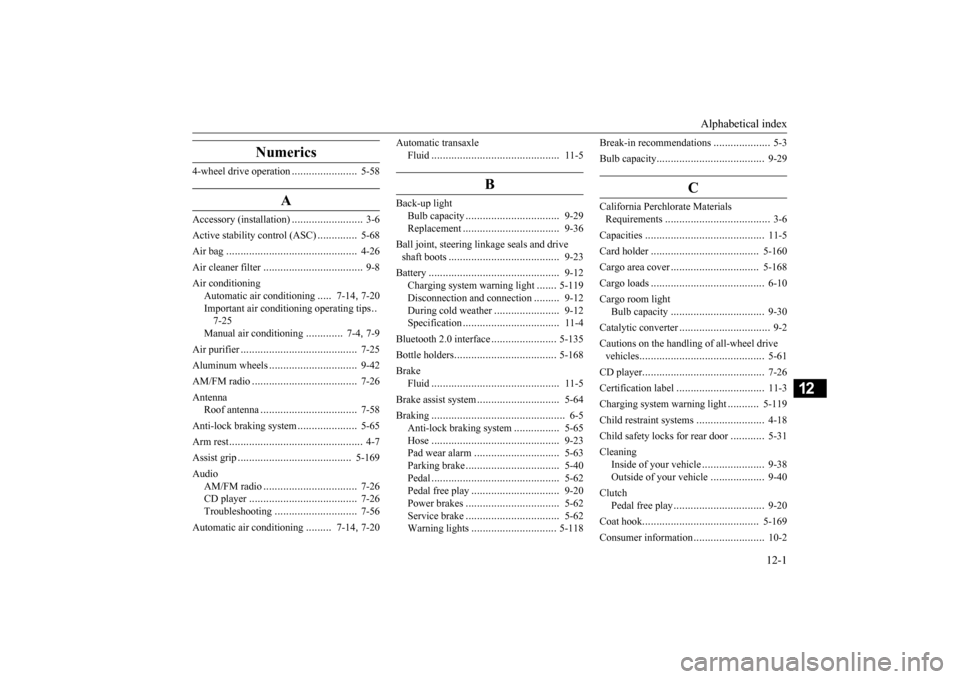
Alphabetical index
12-1
12
Numerics
4-wheel drive operation
.......................
5-58
A
Accessory (installation)
.........................
3-6
Active stability control (ASC)
..............
5-68
Air bag
......................
........................
4-26
Air cleaner filter
...................
................
9-8
Air conditioning
Automatic air conditioning
.....
7-14
, 7-20
Important air conditioning operating tips
..
7-25Manual air conditioning
.............
7-4
, 7-9
Air purifier
....................
.....................
7-25
Aluminum wheels
...............................
9-42
AM/FM radio
....................
.................
7-26
Antenna
Roof antenna
.................
.................
7-58
Anti-lock braking system
.....................
5-65
Arm rest
........................
.......................
4-7
Assist grip
.....................
...................
5-169
Audio
AM/FM radio
................
.................
7-26
CD player
.....................
.................
7-26
Troubleshooting
.............................
7-56
Automatic air conditioning
.........
7-14
, 7-20
Automatic transaxle
Fluid
.......................
......................
11-5
B
Back-up light
Bulb capacity
..................
...............
9-29
Replacement
...................
...............
9-36
Ball joint, steering linkage seals and drive shaft boots
.....................
..................
9-23
Battery
........................
......................
9-12
Charging system warning light
.......
5-119
Disconnection and connection
.........
9-12
During cold weather
.......................
9-12
Specification
...................
...............
11-4
Bluetooth 2.0 interface
.......................
5-135
Bottle holders
...................
.................
5-168
Brake
Fluid
.......................
......................
11-5
Brake assist system
.............................
5-64
Braking
.......................
........................
6-5
Anti-lock braking system
................
5-65
Hose
.......................
......................
9-23
Pad wear alarm
...............
...............
5-63
Parking brake
..................
...............
5-40
Pedal
.......................
......................
5-62
Pedal free play
................
...............
9-20
Power brakes
..................
...............
5-62
Service brake
..................
...............
5-62
Warning lights
..............................
5-118
Break-in recommendations
....................
5-3
Bulb capacity
.....................
.................
9-29
C
California Perchlorate Materials Requirements
.....................
................
3-6
Capacities
.....................
.....................
11-5
Card holder
...................
...................
5-160
Cargo area cover
................
...............
5-168
Cargo loads
...................
.....................
6-10
Cargo room light
Bulb capacity
................
.................
9-30
Catalytic converter
................
................
9-2
Cautions on the handling of all-wheel drive vehicles
.......................
.....................
5-61
CD player
......................
.....................
7-26
Certification label
...............................
11-3
Charging system warning light
...........
5-119
Child restraint systems
........................
4-18
Child safety locks for rear door
............
5-31
Cleaning
Inside of your vehicle
......................
9-38
Outside of your vehicle
...................
9-40
Clutch
Pedal free play
...............
.................
9-20
Coat hook
......................
...................
5-169
Consumer information
.........................
10-2
BK0206700US.bo
ok 1 ページ 2014年3月25日 火曜日 午後4時42分